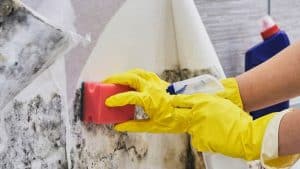If flood waters begin to enter your home, it can be alarming and confusing as to what to do. Safety is always most important and you should never put yourself or others at any risk to preserve property. However, if conditions are safe, the first 24-48 hours are the most critical when it comes to any kind of water damage. It can be difficult to try to think clearly when there is chaos around you but there are certain things you are able to do to help minimize further damage and ensure your restoration goes on without challenge.
Often times when flooding occurs, it can be caused by ground water, falling water, or home water systems. Leaks may not cause flooding, but can also cause many of the same damages when water has been sitting in some areas. If you suspect flooding or water damage in area in your home, you must act rationally. Your home has electrical and many conductive surfaces that run throughout. In most situations, those impacted should try to cut power at their main fuse box. Any additional fuse connections should also be turned off to prevent any fatal electrical accident.
After cutting the power to the fuse box, one would need to take pictures immediately. This would of course need to be done by taking the proper safety measures. In the right conditions, one would need to wear a respirator, gloves, and if there is standing water, some type of waders or protective gear. The purpose of this documentation would be to properly be able to show the damage when it occurred. The pictures will often be used for not only reference, but to help with insured items that can also be seen by the damages.
After taking pictures, it is time to contact your insurance company. They will contact a local insurance adjuster who will come out and do an in person inspection. This will not only verify what the damages are, but allow the company themselves to have representation that is sent to verify an amount they feel is adequate for the damages.
Once you have received collaboration from your insurance company, this allows you to be able to move forward more quickly. Insurance companies will not only tell whether the conditions are not suitable for you to live, but will also pay for you to be temporarily relocated, while the work occurs on your property. For flood damage, this can often be timely to repair, as the restoration company may have to extract the water and remove it from the environment entirely. If this is done improperly, it can lead to mold damage. Mold can often be a property impedance and a health hazard as well. Proper ventilation is required, and sometimes can take weeks to remove standing water. Normally after this phase, one could expect that any drywall or walls damaged by water will have to be removed, due to drywall and wood soaking up water and often being hard to dry out. Water vapor tests will have to be done immediately after the dry out processes, to verify that the water vapor in the air is the correct amount.
Once all the damage is removed, you are able to start the reconstruction process. This is when you are able to build your property back to the standards prior to damages. After this has been completed, insurance companies will normally become less involved, and should return to provide the final check. This will be to ensure that all funds were used and the home was adequately repaired up to your current insurance providers standards as well.
For more info or to schedule a consultation contact us today at 800.922.4410




